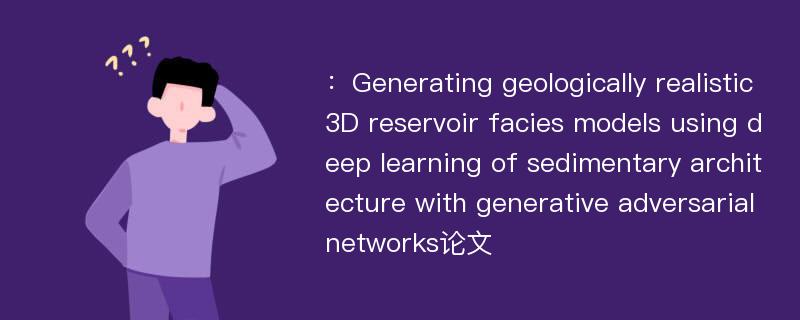
本文主要研究内容
作者(2019)在《Generating geologically realistic 3D reservoir facies models using deep learning of sedimentary architecture with generative adversarial networks》一文中研究指出:This paper proposes a novel approach for generating 3-dimensional complex geological facies models based on deep generative models.It can reproduce a wide range of conceptual geological models while possessing the flexibility necessary to honor constraints such as well data.Compared with existing geostatistics-based modeling methods,our approach produces realistic subsurface facies architecture in 3D using a state-of-the-art deep learning method called generative adversarial networks(GANs).GANs couple a generator with a discriminator,and each uses a deep convolutional neural network.The networks are trained in an adversarial manner until the generator can create "fake" images that the discriminator cannot distinguish from "real" images.We extend the original GAN approach to 3D geological modeling at the reservoir scale.The GANs are trained using a library of 3D facies models.Once the GANs have been trained,they can generate a variety of geologically realistic facies models constrained by well data interpretations.This geomodelling approach using GANs has been tested on models of both complex fluvial depositional systems and carbonate reservoirs that exhibit progradational and aggradational trends.The results demonstrate that this deep learning-driven modeling approach can capture more realistic facies architectures and associations than existing geostatistical modeling methods,which often fail to reproduce heterogeneous nonstationary sedimentary facies with apparent depositional trend.
Abstract
This paper proposes a novel approach for generating 3-dimensional complex geological facies models based on deep generative models.It can reproduce a wide range of conceptual geological models while possessing the flexibility necessary to honor constraints such as well data.Compared with existing geostatistics-based modeling methods,our approach produces realistic subsurface facies architecture in 3D using a state-of-the-art deep learning method called generative adversarial networks(GANs).GANs couple a generator with a discriminator,and each uses a deep convolutional neural network.The networks are trained in an adversarial manner until the generator can create "fake" images that the discriminator cannot distinguish from "real" images.We extend the original GAN approach to 3D geological modeling at the reservoir scale.The GANs are trained using a library of 3D facies models.Once the GANs have been trained,they can generate a variety of geologically realistic facies models constrained by well data interpretations.This geomodelling approach using GANs has been tested on models of both complex fluvial depositional systems and carbonate reservoirs that exhibit progradational and aggradational trends.The results demonstrate that this deep learning-driven modeling approach can capture more realistic facies architectures and associations than existing geostatistical modeling methods,which often fail to reproduce heterogeneous nonstationary sedimentary facies with apparent depositional trend.
论文参考文献
论文详细介绍
论文作者分别是来自Petroleum Science的,发表于刊物Petroleum Science2019年03期论文,是一篇关于,Petroleum Science2019年03期论文的文章。本文可供学术参考使用,各位学者可以免费参考阅读下载,文章观点不代表本站观点,资料来自Petroleum Science2019年03期论文网站,若本站收录的文献无意侵犯了您的著作版权,请联系我们删除。
